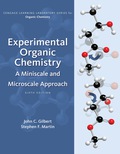
(a)
Interpretation: The miscibility of aniline in water needs to be explained, if in the reduction of nitrobenzene to aniline, the product is readily isolated from the reaction mixture by steam distillation process.
Concept Introduction:A solution is a mixture of solute and solvent. The solubility of solute in solvent depends on the interaction between solute and solvent. It also depends on the polarity of molecules also. As the polar and ionic compounds are soluble in polar solvents on the other hand, non-polar compounds are soluble in non-polar solvents like organic solvents. Therefore it is said to be “Like dissolves Like”.
(b)
Interpretation: The approximate temperature at which aniline and water codistil in the reduction of nitrobenzene to aniline needs to be determined. Here, the product is readily isolated from the reaction mixture by the steam distillation process.
Concept Introduction:A solution is a mixture of solute and solvent. The solubility of the solute in the solvent depends on the interaction between solute and solvent. It also depends on the polarity of molecules also. As the polar and ionic compounds are soluble in polar solvents on the other hand, non-polar compounds are soluble in non-polar solvents like organic solvents. Therefore it is said to be “Like dissolves Like”.
(c)
Interpretation: The normal boiling point of aniline needs to be determined which is formed in the reduction of nitrobenzene to aniline.
Concept Introduction:A solution is a mixture of solute and solvent. The solubility of a solute in the solvent depends on the interaction between solute and solvent. It also depends on the polarity of molecules also. As the polar and ionic compounds are soluble in polar solvents,on the other hand, non-polar compounds are soluble in non-polar solvents like organic solvents. Therefore it is said to be “Like dissolves Like”.
Want to see the full answer?
Check out a sample textbook solution
Chapter 4 Solutions
EBK EXPERIMENTAL ORGANIC CHEMISTRY: A M
- Indicate the products obtained by mixing (3-oxo-3-phenylpropyl)triphenylphosphonium bromide with sodium hydride.arrow_forwardWe mix N-ethyl-2-hexanamine with excess methyl iodide and followed by heating with aqueous Ag2O. Indicate the major products obtained.arrow_forwardIndicate the products obtained by mixing acetophenone with iodine and NaOH.arrow_forward
- Indicate the products obtained by mixing 2-Propanone and ethyllithium and performing a subsequent acid hydrolysis.arrow_forwardIndicate the products obtained if (E)-2-butenal and 3-oxo-butanenitrile are mixed with sodium ethoxide in ethanol.arrow_forwardQuestion 3 (4 points), Draw a full arrow-pushing mechanism for the following reaction Please draw all structures clearly. Note that this intramolecular cyclization is analogous to the mechanism for halohydrin formation. COH Br + HBr Brarrow_forward
- Indicate the products obtained if 2,2-dimethylpropanal and acetaldehyde are mixed with sodium ethoxide in ethanol.arrow_forwardIndicate the products obtained if 2,2-dimethylpropanal and acetaldehyde are reacted with sodium ethoxide in ethanol.arrow_forward2,2-Dimethylpropanal and acetaldehyde are reacted with sodium ethoxide in ethanol. Indicate the products obtained.arrow_forward
- Add conditions above and below the arrow that turn the reactant below into the product below in a single transformationADS fint anditions 百 Abl res condinese NC ง Add on condtions 1.0 B H,N.arrow_forward3. Provide all the steps and reagents for this synthesis. OHarrow_forwardSteps and explanationarrow_forward
 Macroscale and Microscale Organic ExperimentsChemistryISBN:9781305577190Author:Kenneth L. Williamson, Katherine M. MastersPublisher:Brooks Cole
Macroscale and Microscale Organic ExperimentsChemistryISBN:9781305577190Author:Kenneth L. Williamson, Katherine M. MastersPublisher:Brooks Cole Organic Chemistry: A Guided InquiryChemistryISBN:9780618974122Author:Andrei StraumanisPublisher:Cengage Learning
Organic Chemistry: A Guided InquiryChemistryISBN:9780618974122Author:Andrei StraumanisPublisher:Cengage Learning Chemical Principles in the LaboratoryChemistryISBN:9781305264434Author:Emil Slowinski, Wayne C. Wolsey, Robert RossiPublisher:Brooks Cole
Chemical Principles in the LaboratoryChemistryISBN:9781305264434Author:Emil Slowinski, Wayne C. Wolsey, Robert RossiPublisher:Brooks Cole


